CISTEME365 Virtual Institute Equips Teachers to Expose Underserved Students to STEM Via Extracurricular STEM Clubs
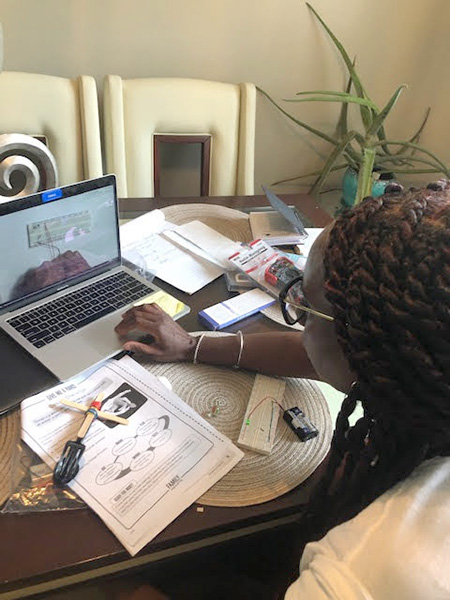
Englewood STEM High Early College and STEM Program Manager Tasha Henderson does a hands-on activity as part of the CISTEME365 Institute. (Image courtesy of Tasha Henderson.)
July 31, 2020
For five days during the period from July 20–30, CISTEME365 (Catalyzing Inclusive STEM Experiences All Year Round), a three-year, NSF-funded program in its second year, held its summer 2020 CISTEME365 Virtual Institute. Its goal? To equip educators to give students quality informal learning opportunities outside of the classroom. The idea was for teams from eight different schools to form or bolster already-existing clubs that pique the interest of under-represented students in STEM (Science, Technology, Engineering, and Math), with the long-term goal of increasing the diversity in STEM.
CISTEME365, an initiative of the University of Illinois’ Grainger College of Engineering in partnership with NAPE (the National Alliance for Partnerships in Equity), provided five days of instruction via Zoom, videos, printed materials, and kits of materials to the 25 or so Institute participants with the idea that they would put into practice both the equity/inclusion training they’d received, as well as try out with their students the fun hands-on, project-based learning activities they’d experienced for themselves.
According to CISTEME365’s PI, Electrical and Computer Engineering (ECE) Professor Lynford Goddard, the program is structured to provide students support via three pillars. The first is each school’s IDEA (Inclusion, Diversity, Equity, and Access) team, ideally comprised of at least three members: a teacher, a counselor, and school staff member. The goal is to provide students with the right kind of support at the schools through people who are passionate about providing STEM-related opportunities for their students. The second pillar is the STEM club itself, where students have learning opportunities about electrical and computer engineering through teaching, videos, and hands-on activities. The third is scholarships available to STEM club members that provide the students with additional high-quality STEM experiences—an immersive exploration of other engineering fields through Illinois’ summer camps.
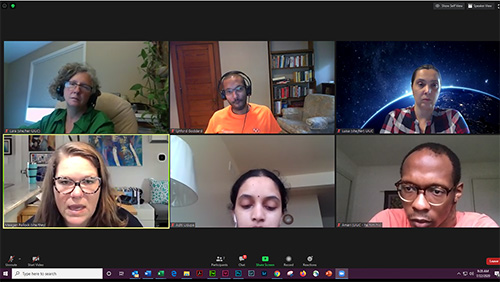
Top left to bottom right: CISTEME365 leadership team members; Lara Hebert, Lynford Goddard, Luisa Rosu, Meagan Pollock, Aditi Udupa, and Amari Simpson participate in a Zoom session.
In addition to the three pillars, Goddard insists that for STEM clubs to succeed, it really needs to be an all-school effort. “I think the structure of the three pillars or the STEM clubs by themselves would not be successful if there is not, also, the right mindset from the administrative staff and the teachers at the school.”
Regarding the need for STEM clubs, Goddard states, “The standard curriculum that students go through in their classes, it's all geared towards specific learning objectives and specific learning outcomes.” Explaining that there isn't much flexibility for students to explore open-ended projects, he adds:
“So we want to be able to provide students with supplies and also guidance and ideas as to how they can explore electrical and computer engineering, how it's accessible to them, and how they're able to try new things out.”
While the hope is that these students succeed in STEM, he adds that, conversely, “It's important that they fail on certain things—so just getting comfortable with ‘Not everything is gonna work,’ and learning to debug and to troubleshoot.”
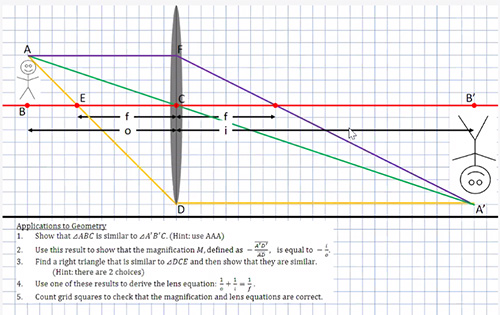
An optics imaging worksheet provided to Institute participants.
Regarding the first pillar, teachers who are passionate about STEM and equity, the main goal of CISTEME365’s summer 2020 Virtual Institute was to equip the 25 participating educators, representatives from the eight new schools comprising the year two cohort, which were mostly from the Chicago area: Richard T. Crane Medical Preparatory, DeVry University Advantage Academy, Englewood STEM High, Marine Leadership Academy, Jane A. Neil Elementary, Roosevelt Community Education Center, Daniel Hale Williams Preparatory High, and Wolcott College Prep.
Also participating were two educators from John M Smyth IB World Elementary, one of the five schools in last year’s cohort who had received similar training. Of those five schools, four had implemented STEM clubs (the outbreak of the COVID-19 pandemic significantly hindered one school's efforts.)
Like last year's Institute, educators will receive a stipend of up to $1,200 for participating team members. However, the main difference in this year's Institute compared to last year’s, of course, was that it was virtual; rather than participants gathering on campus, everything was offered on-line. Plus, leadership significantly restructured the institute itself, realizing that people wouldn’t be able to dedicate two weeks on zoom calls from 8:00 AM to 5:00 PM. So while last year’s in-person event was from 8:30 AM to 5:00 PM, with a lunch break, and for two weeks straight, this year’s sessions were for five days over a two-week period, and only five and a half hours of content from 8:30 AM to 3:00 PM with a lot more breaks in between. “We're essentially shortening the day because I don't think that people will get a lot out of an eight-hour zoom meeting,” Goddard admits. In addition, because the Institute is virtual, they weren’t able to do some of the things that they did last year, like tours of the ECE Building’s teaching lab space.
 In a video, Goddard demonstrates how to do the circuit activity.
In a video, Goddard demonstrates how to do the circuit activity. Another change this year is that the CISTEME365 team sought to set clear expectations regarding what it means to participate in the program—that it’s more than just a few sessions of professional development. Thus they tried to set out expectations of “what it means to launch a STEM club at the school, and why we have counselors participating…why it's important for them to learn the materials.” (Counselors were included because they need to believe underrepresented students can be successful in STEM, not tell them, “That’s not for you; try this instead!”) They also worked to put more of the materials in video format, as a companion to the textbook—tutorial videos that go along with the content.
“The textbook lays out the activities step by step,” Goddard explains, “but in the remote environment, sometimes it's hard for either the students or the instructors to fully do all the activities on their own; there's questions that they have.”

Meagan Pollock teaches the educators about equity, stereotypes, and bias.
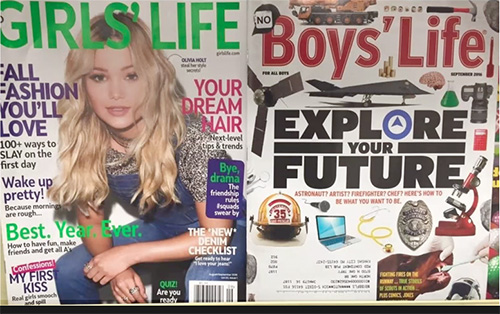
Two magazines, one for girls and one for boys, and how they shape gender stereotypes in kids.
Another change this year will be having Aditi Udupa hold office hours for the STEM clubs and the teachers during the school year. Based on feedback from last year, “The teachers and the counselors wanted the opportunity to work with someone as they're running their activities,” says Goddard, “either during the lifetime of STEM club or in advance, as they're preparing for that day's activities. So we've added that component to this year.
However, much of the content was similar to last year’s. For instance, to ensure that schools’ IDEA Teams were equipped to promote diversity, Meagan Pollock once again provided training on equity, labels and stereotypes, bias, and self-efficacy. Regarding labels, she addressed how they can influence educators’ interactions with students and the impact of labels on students.
When addressing stereotypes, Pollock included a quote from a TedTalk given by Chimamanda Adichie, “The Danger of a Single Story: “The single story creates stereotypes, and the problem with stereotypes is not that they are untrue, but that they are incomplete. They make one story become the only story.” As an example of widely held and perpetrated stereotypes, Pollock showed two magazine covers (to the right) that are rife with the types of gender stereotypes that shape children. The girls are portrayed as only being interested in how they look—in make-up and glamor, being popular, and boys. The boys are stereotyped as being concerned about their future careers, and interested in engineering and science.
Pollock also addressed bias. Indicating that we all have it, Pollock defined it in the following way:
“Bias is a prejudice in favor of or against one thing, person, or group compared with another, usually in a way considered to be unfair. As a verb, bias causes one to feel or show inclination or prejudice for or against someone or something in explicit or implicit ways.”

A slide in a Video training session about resistors.
Also provided were sessions or brief breaks where school teams could create an Action Research for Equity Project (AREP) to broaden STEM participation through their club which they would hopefully implement in the following school year.
In addition to training the educators to promote inclusion, the institute was also structured to provide participants with skills they would need to lead cutting-edge-yet-fun, STEM-related hands-on and other activities. Some of the project-based activities educators experienced included Design of an Experiment, Optics, Circuits, Breadboarding, Algorithms, Designing an LED Calculator, Waves and EM Signals, and Signal Processing. Many of these Goddard had perfected as part of his long-standing GLEE (Girls Learn Electrical Engineering) camp, which, as of last summer, was no longer just for girls, but encouraged both girls and guys to learn electrical engineering. However, giving a nod to the COVID-19 quarantine virtual world in which we now live, Goddard and his team also incorporated some new, internet-based activities, like web-based sound visualizers.
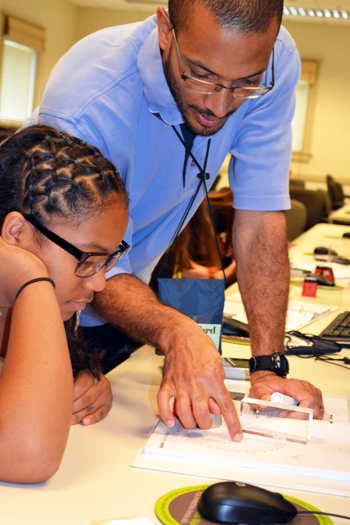
In a 2013 GLEE GAMES camp, Lynford Goddard gives a camper some one-on-one instruction during a session on optics.
This activity involved talking about signals and processing of data, with students being able to hear it and visualize it on their browsers. While Goddard acknowledges that, “We may not have the same in-person STEM club experiences for the upcoming school year,” he indicates that “There was definitely a lot of effort and thought put into…which parts of the material could be redeveloped so that it's more accessible to people from their own homes.” In fact, the web-based sound visualizer program was developed by ECE senior Siwei Xian to be able to run on smartphones. “So students from home either on their web browser or on their smartphone can still get that experience that we used to only be able to do in the lab.”
In addition, the Institute provided PD related to campus admissions and mock application review, plus information about available STEM careers.
While “365” and “year-round” certainly suggest week-in, week-out student exposure to STEM via school clubs, they also allude to the continuous training and networking provided through CISTEME365. Once the summer institute is over, the support doesn't stop. In addition to summer training, Cohort 2020–21 educators will receive additional PD once a month throughout the academic year. Plus, CISTEME365 will promote networking and foster community across schools in the cohort throughout this next year, via a conference call and/or other online networking platforms. Plus, once the year is complete, Grainger College of Engineering intends to continue networking/collaborating with the schools.
Several participating educators shared about why they had gotten involved with CISTEME365, their favorite hands-on activities, and what they had gleaned from the Institute that they hoped to implement at their schools. For instance, Tasha Henderson, the Early College and STEM Program Manager at Englewood STEM High School, shares that by participating in CISTEME365, she hoped to increase accessibility—“to bridge the equity gap for all of our students and extend our students’ critical thinking to project-based learning and even challenge our advanced students through various enrichment activities.”
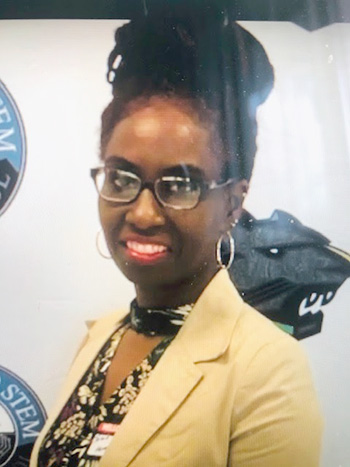
Tasha Henderson, the Englewood STEM High School Early College and STEM Program Manager. (Image courtesy of Tasha Henerson. )
Henderson claims her favorite hands-on activity was the breadboard/circuit-building activity. In fact, she enjoyed it so much, that she admits “I have built a few circuits as a reinforcement of the concept.”
Henderson acquired quite a few take-homes from the Institute that she hopes to implement at Englewood. “I have learned a wealth of crucial information to support our students in project-based learning activities, but also the social-emotional supports surrounding equitable access in STEM instructional practices.”
Regarding why STEM clubs are so important, Henderson claims they help prepare students to make a difference in the future.
“It is vital to have a STEM Club at Englewood STEM HS because it exposes students to the various STEM fields of study. In efforts, it gives our students a firm foundation for college and career readiness opportunities in their communities and reaching local and even global innovation contributions in the 21st century.”
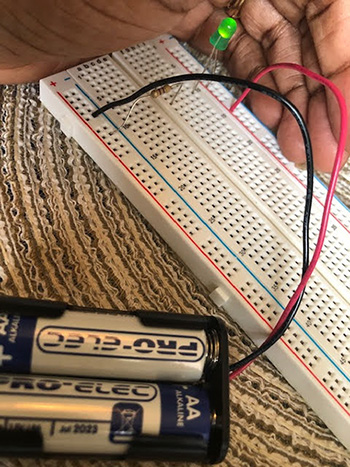
Tasha Henderson's LED glows in the top right, indicating that she has completed the activity correctly. (Image courtesy of Tasha Henderson.)
Another educator, Charles Hallowell, who teaches chemistry and physics and is the robotics coach at Roosevelt Education Center in Rockford, Illinois, admits that the department lead volunteered him to participate in CISTEME365; however, he then acknowledges, “but I already was deeply concerned by the disparities facing underrepresented groups in entering STEM fields.”
Hallowell’s favorite hands-on lesson was the "Give-Me-a-Hand" exercise. “I think that the engineering design process works very well in this lesson,” he says, “and it creates a variety of decisions that make students engage critically without scaring them away with math or burning out circuits,” then confesses, “I AM excited to burn out a bunch of circuits with my robotics team, though.”
He also hopes to increase participation by underrepresented students. “I hope that through use of these tools (both the hands-on, inquiry-based lessons and the equity-building lessons), I will be able to address some of the preconceptions that often serve as the initial barrier to student involvement. I am also hopeful that I will also become more aware of the norms that I passively promote and how to make them more inclusive.”
While Hallowell reports that because of transportation issues, his school doesn’t offer extracurricular activities such as sports or other after-school activities, somehow his Robotics club is thriving, though he admits time issues are a challenge—and he particularly struggles with organization and delegation.
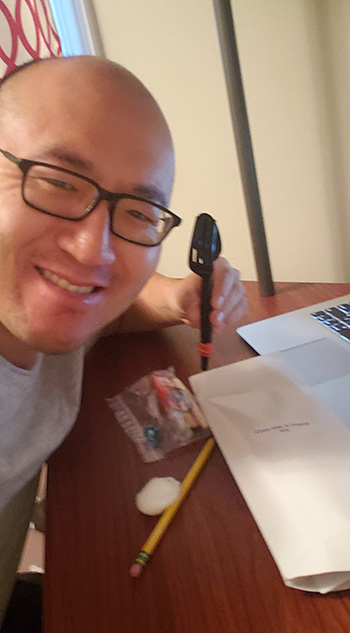
Wolcott science teacher Kenny Bae does a hands-on activity during the CISTEME365 Institute. (Image courtesy of Kenny Bae.)
Despite those challenges, he acknowledges: “The value I've seen in the last two years is amazing, though. Students end the year with quite a bit more confidence and a few more soft skills when it comes to working on a project as a group and as a competitor.”
Kenny Bae, a science teacher, robotics coach, and faculty founder at Wolcott College Prep shares why he participated in CISTEME365.
“I came from a low-income family background, and I always struggled with math and science,” he admits. “I learned over time to enjoy STEM-related fields and that it allowed me opportunities to be successful being in a STEM career.” Acknowledging that Wolcott is a non-profit private school that supports students with learning differences, he says they deliver education in a way that is customized to the learning styles of their students. “I'm participating in CISTEM365 because it provides our underrepresented students opportunities in STEM careers and technical knowledge,” he admits.
In terms of his favorite hands-on activities, Bae stresses, “I loved all of the hands-on activities.” However, his favorites were the "Give-Me-a-Hand" activity and the algorithm card set.
Regarding what he learned at the Institute that he hopes to implement at Wolcott, Bae explains, “I learned how to support underrepresented students by applying knowledge from PD, such as micro-messaging and self-efficacy, then adds that he hopes to use the electronics kit, breadboards, and teach his students about micro processing and algorithms.
Why is it important to have a STEM club at his school? Bae echoes Goddard’s belief that while engaging in STEM, it’s important for students to have an opportunity to fail now and then:
“I think a club is one of the best ways to engage students in science, technology, engineering, and math. It's a low-stakes environment where students can take risks. There is no pressure to have grades, so students are more willing to take chances. They are allowed to make mistakes and learn from their mistakes. Clubs allow students to explore, try new things, gain knowledge, skill sets, and understanding.”
Author/Photographer: Elizabeth Innes, Communications Specialist, I-STEM Education Initiative
More: CISTEME365, Electrical and Computer Engineering, Teacher Professional Development, 2020
For additional istem articles on CISTEME365, please see:













.jpg)
















